Monday, 23 August 2021
Fascinating untold stories of the rise and fall of Nottingham’s world-famous lace industry are being brought to life thanks to new research by historians at the University of Nottingham.
The city is well known for the lace and hosiery manufacturing that was pioneered in the early 19th century, reaching its international trading peak at the height of the British Empire. However, less well known is Nottingham’s status as a global trading centre for the machinery and expertise that allowed other countries to establish their own lace industries and markets.
The Global Lace Market project has been funded by Arts Council England and Nottingham City Council to help in the creation of new visitor attractions in the city. These will include a new Lace Gallery at the Industrial Museum at Wollaton Hall, an interactive exhibition at Newstead Abbey and workshop events at Nottingham Castle.
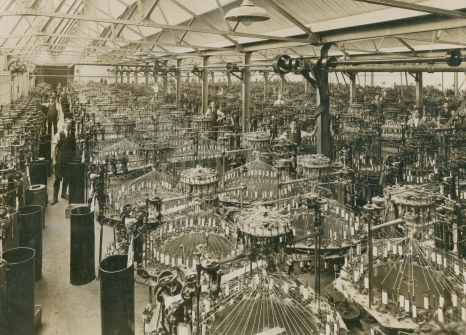 Lace factory in Nottingham, 1865 ©University of Nottingham Manuscripts & Special Collections
Lace factory in Nottingham, 1865 ©University of Nottingham Manuscripts & Special Collections
Researchers from the university’s Department of History have uncovered just how vital export trade was to the success of Nottingham’s lace industry. The largest markets for Nottingham lace were France, Germany, the United States and South America. Manufacturers also exported to Spain, Egypt and India. Between 1850 and 1950 many foreign consulates were opened in Nottingham securing links with America, Germany, Norway, Chile, Argentina, Spain, Costa Rica, Venezuela, France, Colombia, Salvador, Uruguay, Nicaragua, Cuba and Dominica.
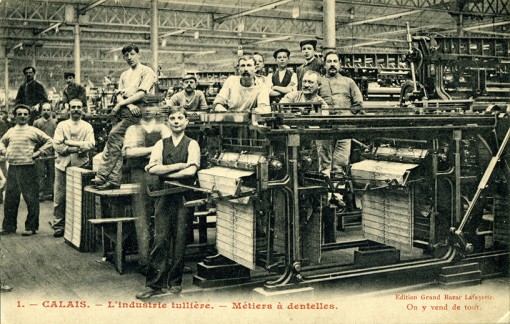 © Cité Dentelle Mode, Ville de Calais
© Cité Dentelle Mode, Ville de Calais
The new research has also revealed more human stories about the lives of the immigrant lace workers, merchants, factory owners and foreign traders who moved to Nottingham, as well as the local people who emigrated to Long Island, New York, and Calais, France to set up lace and hosiery factories with Nottingham-made machinery.
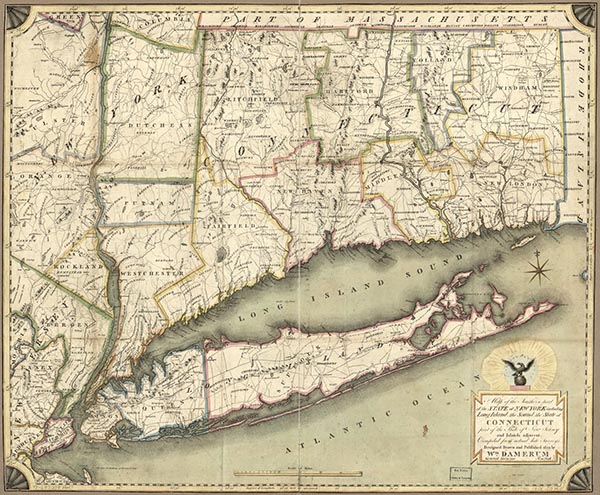 © Library of Congress
© Library of Congress
Nottingham was not just the leading centre for lacemaking but also a global trading centre to which foreign workers, merchants and government officials flocked in search of knowledge, lace commodities and machinery. At its height, in the 1890s, the lace industry in Nottingham employed 25,0000 mostly female workers which slowly fell to just 5,000 by the 1970s as manufacturing steadily declined amid growing foreign competition.
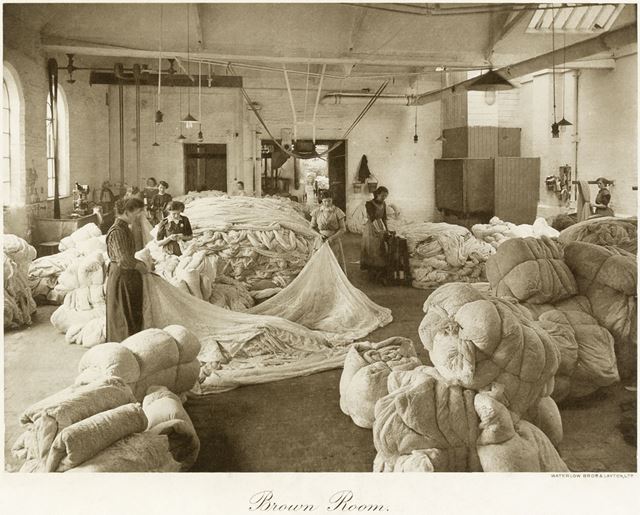
 Dr David Gehring, Department of History, University of Nottingham
Dr David Gehring, Department of History, University of Nottingham
Leading the Global Lace Project, Dr David Gehring, said: “Nottingham has long been famous for its lace industry, but this new research has delved deep into a large number of previously unscrutinised materials here at the university’s Manuscripts and Special Collections, the Nottinghamshire Archives, and the Nottingham Museums and Galleries Lace Collection. Few local people living here today may know that over a century ago there were foreign consulates in the Lace Market area, and that the city was home to substantial communities of Germans, French and Americans working as merchants and manufacturers, some of whom stayed and became permanent British citizens. The tales uncovered by Dr Joesephine Tierney will bring these aspects to life in the new visitor attractions planned for Nottingham in the months to come.”
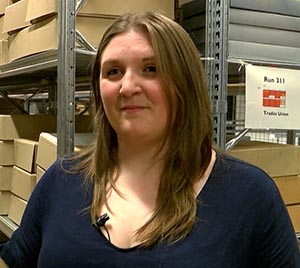 Dr Josephine Tierney, Global Lace Market Project Researcher
Dr Josephine Tierney, Global Lace Market Project Researcher
Dr Tierney is a post-doctoral researcher who has spent the past six months investigating the lace archives and her full report has now been delivered to the city council’s Museums and Galleries Service. Her previous experience and expertise in the history of textiles and international connections were invaluable for this project, and she has genuinely shined a light never before seen here in Nottingham.
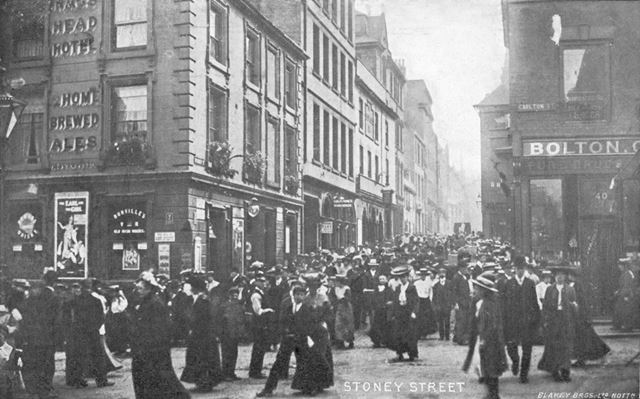 Lace Workers on Stoney Street, c.1900-1910 © Picture Nottingham
Lace Workers on Stoney Street, c.1900-1910 © Picture Nottingham
Dr Tierney said: “I’ve been very struck by the cosmopolitan nature of Nottingham’s lace industry by the turn of the 20th century. The 1901 census, for instance, includes over fifty men and women of German origin who were connected to the lace trade as merchants, agents, manufacturers, or workers. This had risen to at least a hundred by 1911. There was also a German social club on Market Street which was a cultural and social hub for German nationals living in Nottingham. Conversely, some Nottingham families emigrated to Germany, sharing their expertise with new lace factories in Plauen, between Dresden and Nuremberg.
“The outbreak of WW1 caused problems for Nottingham’s lace links with Germany of course. The war stopped all trade with Britain and the German government seized foreign-owned businesses and interned British lace workers in enemy camps for the duration. German families in Nottingham also faced similar difficulties as ‘enemy aliens.’
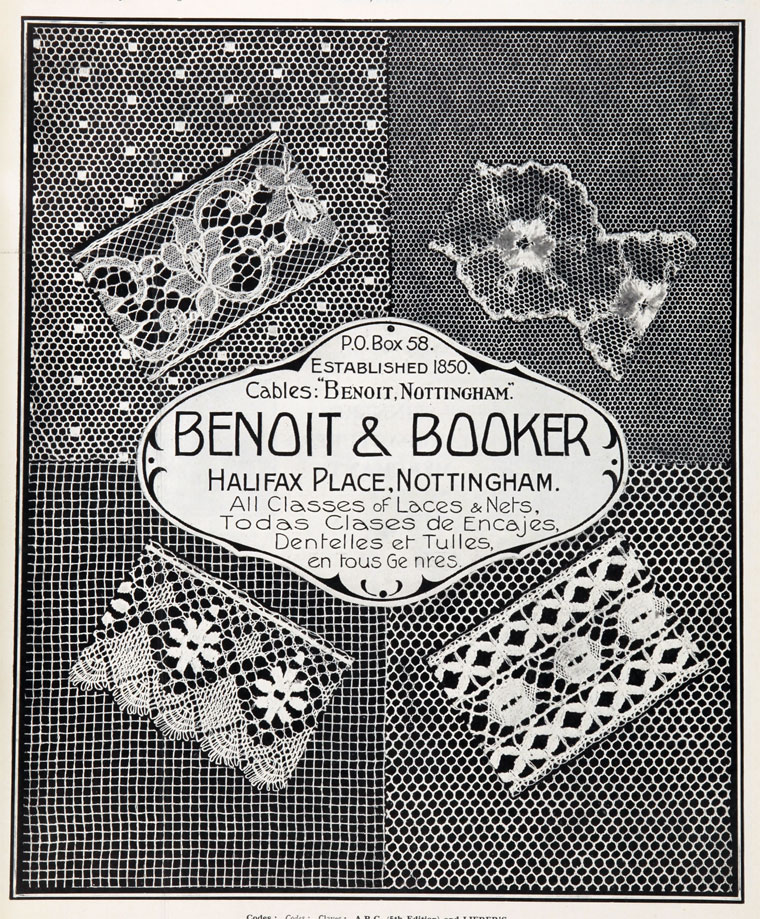 Advert for Benoit & Booker, 1922-1923. © Grace’s Guide to British Industrial History
Advert for Benoit & Booker, 1922-1923. © Grace’s Guide to British Industrial History
“We also discovered that, at its height, there were over seventy French-born men and women, many British by parentage working in the lace industry in Nottingham. Between the middle of the nineteenth century and the early twentieth century, a handful of Americans also emigrated to Nottingham and Nottingham families journeyed to America to help establish a lace industry in Patchogue, Long Island. By the early 1890s, there were also two lace mills in Wilkes-Barre, Pennsylvania and three in Philadelphia. In 1900, the Nottingham lace trade expanded to the township of Zion, Illinois. So many American families living in these areas today will have Nottingham-born lace-making ancestors!”
Despite fierce debates at the time about the dangers of exporting skill and industrial technology abroad, this globalisation was a key factor in the eventual decline of the lace industry in Nottingham, its birthplace.
 Councillor Eunice Campbell, Portfolio Holder for Leisure and Culture, Nottingham City Council
Councillor Eunice Campbell, Portfolio Holder for Leisure and Culture, Nottingham City Council
Nottingham City Council’s Portfolio Holder for Leisure and Culture, Cllr Eunice Campbell-Clark, said: “It is wonderful for the city that the research gives visitors the opportunity to learn about the Lace Market, and its’ findings will inform our subsequent redisplay of the textile machinery gallery at Nottingham Industrial Museum, and temporary exhibition content from spring 2023 at Newstead Abbey & Gardens.
“It is our aim that these developments will further attract visitors to these cultural venues, and will be popular with any visitors from Nottinghamshire and beyond who would like to discover more about the Lace Market, the cultural heart of Nottingham.”
 Ron Inglis, Chief Operating Officer, Nottingham City Council’s Museums and Galleries Service
Ron Inglis, Chief Operating Officer, Nottingham City Council’s Museums and Galleries Service
Nottingham City Council’s Museums and Galleries Service Chief Operating Officer, Ron Inglis, said: “We are thrilled with the research findings – and are particularly grateful for funding from Arts Council England which has secured this project and allowed this research to take place.
“It is a fantastic project that enables us to work collaboratively with our research partner at the University of Nottingham, volunteers from Nottingham Industrial Museum Ltd, and Nottingham Castle Trust, as well as working with the wider community.”
“The results will considerably enrich our knowledge of the collection, inform our new displays and future interpretation at the site, as well as provide a huge amount of information for volunteer tours and activities.
The Global Lace Market project has been funded by the Arts Council as part of the Designation Development Fund, aimed at promoting greater understanding of, and public engagement with, collections of national and international importance.
Story credits
For more information, please contact Dr David Gehring, Department of History, University of Nottingham via email david.gehring@nottingham.ac.uk or Emma Rayner, Media Relations Manager on 07738 291242 or emma.rayner@nottingham.ac.uk
Notes to editors:
About the University of Nottingham
Ranked 97 in the world and 17th in the UK by the QS World University Rankings, the University of Nottingham is a founding member of Russell Group of research-intensive universities. Studying at the University of Nottingham is a life-changing experience, and we pride ourselves on unlocking the potential of our students. We have a pioneering spirit, expressed in the vision of our founder Sir Jesse Boot, which has seen us lead the way in establishing campuses in China and Malaysia - part of a globally connected network of education, research and industrial engagement.
Nottingham was crowned Sports University of the Year by The Times and Sunday Times Good University Guide 2024 – the third time it has been given the honour since 2018 – and by the Daily Mail University Guide 2024.
The university is among the best universities in the UK for the strength of our research, positioned seventh for research power in the UK according to REF 2021. The birthplace of discoveries such as MRI and ibuprofen, our innovations transform lives and tackle global problems such as sustainable food supplies, ending modern slavery, developing greener transport, and reducing reliance on fossil fuels.
The university is a major employer and industry partner - locally and globally - and our graduates are the third most targeted by the UK's top employers, according to The Graduate Market in 2024 report by High Fliers Research.
We lead the Universities for Nottingham initiative, in partnership with Nottingham Trent University, a pioneering collaboration between the city’s two world-class institutions to improve levels of prosperity, opportunity, sustainability, health and wellbeing for residents in the city and region we are proud to call home.
More news…